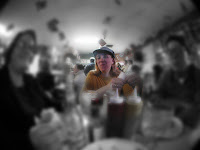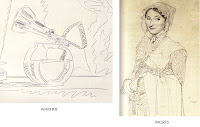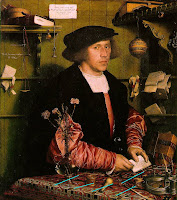I wrote about the role that Leonardo Da Vinci has played in my artistic development; some of these stories you may have read here before, in slightly different forms. Which versions are true? All of them, I think.
Unlike my usual use of the spastic theory of blog writing, these posts have been edited, by the marvelous Courtney Jordan. In a few places, I've gone back to my original text, but not many.
Apart from being proud to have had this block of writing posted at Artist Daily, I'm particularly thrilled that this is my first writing to make it onto class syllabi. My friend Kathleen Rooney, a wonderful poet and author, is teaching the compiled essay this winter quarter at DePaul, in her intermediate poetry class, and in the spring at Roosevelt, where she is writer-in-residence, in her graduate poetry workshop.
Here you go - you may notice the tone is slightly less profane than usual. Hopefully, it is a little more polished as well.
The Importance of Choosing a Master
Let's say you're Egon Schiele. You have a singular vision so original, so violently intense, that you can develop as an artist by feeding exclusively on your own inspiration. Your drive will crush every obstacle in your way - even feed on them, transforming your mistakes and flaws into revelations.
Now let's say you're you or me. We might be good or talented - maybe we'll even become great. But in order to get where we’re going, we have a body of technical skill that we need to add to our toolboxes. What should we do about that?
My first step was to choose a master. This master, preferably someone safely dead, will act as your pole star. This master will be someone not only of massive artistic accomplishment, but of formidable technical skill. By studying the master's work, you will find both inspiration in terms of what art can express, and insight into how art expresses it. Your master will have produced work of such technical sophistication that you can spend hours poring over his or her work, learning new lessons as your own skills advance enough to prepare you for further growth.
I chose Leonardo Da Vinci. In the next few posts, I will describe to you how and what I learned from my years of studying Da Vinci.
But in the meantime, I want to share with you what I think is the most important reason to choose a master: you should always be thinking of an artist better than you. It is important in the process of becoming an artist to think that you are the best artist who has ever walked this humble Earth.
But it is just as important to think that you are nothing, that you are the lowest of the low. Very little inspires the will to improve like the company of someone who demonstrates that there is still room to improve. When you depend only on yourself, you depend on the inspiration of one person. When you have a master, you depend on the inspiration of two. A conversation is often a better place to learn new things than a monologue.
Learning the Lesson of Line Drawing
Choosing a master means taking a close look at great art and great artists, and learning the lessons they can teach you. But they can teach you only what you are ready to learn. When I began earnestly studying Da Vinci, what I was ready to see in his work was line; that was the lesson I was ready to learn.
For my part, I am in love with seeing, in love with truly and deeply looking at the thing - a figure, an object, a landscape - that I see before me. The world is a treasure chest of marvels, and I have always wanted to be able to make a picture of what I see, as I see it. There are great artists for whom accuracy of physical representation is not a key concern - Odillon Redon, Gustave Moreau, and Hieronymous Bosch, to name a few.
But that's not the direction that I'm pulled in and, because of the quirks of how my brain works, line is a particularly important tool for me in my ambition to draw as I see.
When I first started looking at Da Vinci's work, my own lines were chaotic. They didn’t go where I wanted them to go and they didn’t make a good picture of the thing I was seeing.
In contrast with the clumsy lines in my figure drawing, Da Vinci’s lines glided over the edges of forms, gracefully defining and evoking them.
I conceived a concept of the Perfect Line - a line neither too detailed nor too simple, the pure line of nature itself. This perfect line was so utterly matched to its subject that all trace of the artist vanished. And for me, Da Vinci had perfect line. It’s basically a mystical idea which, like the idea of the master, gives you a great thing to struggle toward.
But Da Vinci’s edges weren’t his only perfect lines. His hatching, so simple and evocative, told the story of light and dark inside his forms. Both the contours and the shading in his drawing of the head of an angel are effortless and natural.
Over time, I learned to draw better, maybe because I was making the effort. One of the main benefits of the entire project was that it inspired me to practice - to constantly practice.
As you can see from the more recent drawing, I did eventually move my line closer to Da Vinci's. It became more subtle, fluid, and accurate. But it also became mine - in seeking to become like Da Vinci, I found that my practice allowed me to become myself.
How to Make Sense of All Those Bumps and Ridges
Back when I was struggling to pull my drawing abilities together, I realized that it didn't matter how good my line got if I couldn't tell what I was looking at. This came to a head when I was faced with the task of a figure drawing of the human body, specifically, the back.
If you've gone through life drawing, perhaps you know the problem: you're sitting in your workshop, a reasonably muscular man is posing, his back is turned to you, and... what is going on? What are all those bumps and ridges? How are you supposed to make sense of that complicated mess? You know there's an order, an underlying structure to it, but you simply cannot make it out.
Fortunately for me, I knew how Da Vinci would solve this problem: he would draw from anatomical dissections. So that's exactly what I did. I was living in Los Angeles at the time, and Santa Monica Community College offered a gross anatomy course, with cadavers. I applied to take it as an artist, a first for them. They talked it over and allowed me to enroll. My professor was Dr. Margarita Dell, an incredibly generous teacher.
 Drawing anatomy allowed Leonardo to understand
Drawing anatomy allowed Leonardo to understand
how the human body works in relation
to its appearance.
My initial plan was to draw only structures relevant to life drawing and to basically skip the organs. But the program was so fascinating that my one-semester course expanded into a two-year, 100-drawing project covering every part of the body I could think of.
When I began, my drawings were crude. I worked largely in line alone and wasn't sure how to visually recreate the look and feel of the skin, muscles, and bones that I was seeing.
By the end of my body drawing project, I had not only developed an idiom for drawing muscles, but a deeper understanding of their nature: how they connected to bone, how they lay over each other, and how their fascia coverings affected their shapes.
Apart from the delight and learning I had throughout this project, I got the benefit I wanted—the musculature of the living human body became comprehensible to me. When I went into life drawing, I did not depend on my eye alone to comprehend what I saw. I had a broad view of the internal structures of the body in mind as well. I could finally see through the skin, to the underlying fat and muscle and bone, and how the interactions of these parts with mechanical and gravitational forces determined the body's visual appearance.
If you are engaged in a serious way with strictly representational life drawing, I cannot recommend gross anatomy highly enough. The simpler alternatives - textbooks, photographs, écorché courses, the "Body Works" exhibits - work as well. The key is to spend enough time in studying and copying these anatomical parts that the knowledge sinks in at a deep level and informs your eye without your command.
Painting Portraits with Personality, Mood, and Character
I've described the most important technical parts of my study of Da Vinci: line and anatomy. When I began to study how to paint, I opted not to follow his methods, so I haven't got anything to share with you about the famous sfumato, admirable though it is.
Let me explain something about how I learn about art; a quirk, perhaps, of being self-taught. I usually don't read books by or about my subject. I've read snippets of Da Vinci's notebooks, but haven't made anything like a complete study of them. I am only sketchily aware of his biography and his role in Western art. I like to learn by looking at things, and I think I've been served well so far by this practice, even if I have woeful gaps in my knowledge.
One of the most important things I learned from Da Vinci was in line with this practice of looking at things. It was simply this: his figures and portraits have so much soul. I have spent hours in the National Gallery in silent conversation with his bewitching Ginevra di Benci.
How long can you talk to a painting? It's a good question. I think it has to do with how much personality is present in the painting itself. Ginevra is multi-sided. She looks as if she has a personality, and moods, and thoughts. She appears complex and self-possessed. She serves a role in no story but her own, and she's not entirely interested in telling you what her story is. So my approach to this picture is a pilgrimage to her; it is not hers to me. This is a picture, but it is not a show.
Da Vinci's portrait paintings brim with substance and presence. Consider the angel Gabriel in the Louvre version of the Madonna of the Rocks (yes, that's the one Dan Brown thinks is spooky).
This Gabriel is a trouble-maker. The lower lids of his eyes are clenched with fun, and his mouth is breaking into a smile. The eyes are looking at something specific that isn't in the painting. You, observing the painting, have caught part of an ongoing story, and the character of the participants is evident, but the story remains mysterious. There's something threatening about that smile, about the knowledge the angel has, which you do not have and cannot get. Again, we see a full, self-willed character, inviting us to sink into extended inquiry during our encounter with the painting.
What I learned from these studies is that for the pictures of people that I want to do, line, form, color, and light are not enough. They are the servants, not the master. They are what depicts, not what is depicted. What is depicted is the human presence. The success of the drawing or painting is to be measured in relation to the human presence, not the elements of visual design.
I finished this painting just recently. The model's name is Piera. My paintings of Piera look a little Da Vinci-ish from the get-go because Piera herself looks a little Da Vinci-ish. In this painting, I wanted as much as possible to eliminate everything but Piera, the person. There are no clever ideas, no exciting bits of design. Just Piera.
I've been working with Piera for close to three years. If you're interested as I am in the humanity of your sitter, I believe it is important to work with models for a long time, to develop a textured sense of who they are. Piera had her first child a year ago, and she is very happy and very tired. All those things went into this painting, but they don't necessarily come back out of it. You might not know her story or anything about her. Would she still be interesting? Would you still stand a while with the painting because you want to get to know her better?
I don't know, but I'm trying.
Making Art According to Leonardo da Vinci's Motto
This is said to be Da Vinci's motto:
Ostinato Rigore
It translates to something like “persistent rigor.”
Charles Darwin changed the world. Somebody once remarked on his genius, and he shot back that he was no genius but rather, had put in the hours. From the outside, Darwin looks like a genius.
Few match, and none surpass, the genius of Da Vinci. But Da Vinci himself may not have seen it that way. In his very motto, Da Vinci reminds himself to put in the hours. We can learn from this another vital lesson. Yes, there is such a thing as talent. There are prodigies out there in the world. But the pencil and the brush hide continents of complexity. A prodigy may pick up either one and make a great thing the first time he or she tries. But to make a life of it – to produce a great body of work, perhaps to change the world as Darwin and Da Vinci did – takes persistent rigor.
Beauty and truth are fine things, and they live on a high mountain. Sometimes, in the dreams of talent and prodigy, we fly up and touch them. But it is only by climbing a little bit, every day, that we can hope to make a home with them, and share their company for an extended time. Some people are born with talent, but nobody is born with skill. Skill is the mastery of materials and techniques, and there is no way to get it except by practicing, by showing persistent rigor.
When you are at the point of tearing out your hair, remember: Da Vinci cautioned himself to practice too.
I am not claiming either painting is better, but without my figure drawing practice between 2004
and 2011 I couldn't have painted the newer painting.
Meet Your Master and Then Throw Him Away
Sad is the disciple who does not advance his master.
--Leonardo da Vinci
Maybe you remember - in my earlier post when I recommended that you choose a master - I remarked that it was generally a good idea for the master you chose to be safely dead. There's a reason for that.
Any sufficiently accomplished living teacher puts his or her students in danger, of turning into slavish copyists of the teacher. Frank Lloyd Wright, for example, taught a generation of students - to design Frank Lloyd Wrights. They became convinced that there was one right way to make a house, and that it was the Frank Lloyd Wright house. Who they were as individual architects died. They became cultists. This was not necessarily Frank Lloyd Wright’s fault. Of course he thought he was right. The problem was that his living presence was overpowering.
Da Vinci says that to do right by your mentor or master you must "advance" him or her. The simple reading of this is, "become better than your master." And that would be good, but it is not always possible. Another interpretation is that you should move to a different place on the map from that of your master. Da Vinci, one of the greatest masters, is saying, "Learn everything you can from your master - but then abandon him. Become your own artist."
 For this brush and ink drawing, I applied what I learned from
For this brush and ink drawing, I applied what I learned from
da Vinci, but moved in my own direction.
This is easier if your master is dead to begin with. A dead master's work is as complete as it will ever be. You are at liberty to peruse the entire body of work, to consider the words, to reflect on the painting or drawing ideas, to steep yourself in the philosophy of their approach to art. You can turn it all over in your mind, for years if you need it - as I needed it. And then, when you are done, there is nobody around to suggest, even subtly, that doing it your own way is doing it wrong.
Choose a master - master your master - and then throw away your master. You will need to depend on their inspiration when you are a student. When you are ready to depend on your own inspiration, when you have the tools you need to execute your vision in the world, then you have graduated, and you become your own master.



















